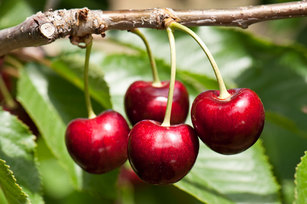 INSTITUTE FOR NATURAL RESOURCES
INSTITUTE FOR NATURAL RESOURCESYou are here
Farming and Agriculture
Forestry and Agriculture
- Intro
- Planning Resources
- Research Projects
- Articles & Stories
- Maps & Tools
- Reports & Publications
- Data
- Photos & Videos
- More
Oregon's Bounty of Horticultural Crops and Landscapes

Oregon's history in the production of fruits, berries, vegetables, and ornamental crops has given the state a national and international reputation for high quality products. The soils, micro climates, and rainfall distribution here have made Oregon ideal for the production of food crops, including fruits and nuts, berries, wine-grapes, vegetables, grains, beef, dairy; and non-food crops such as vegetable seed; ornamental plants, and Christmas trees.

Strawberries (Oregon Department of Agriculture).
Once, agriculture and forestry were the foundation of Oregon's economy. Although other activities now are equal in size to land-based enterprises, agriculture continues to make a significant contribution to Oregon's economic well-being. Agricultural production, processing, marketing channels, and the global palate are changing rapidly as economies globalize. The trend toward local marketing may be most visible to consumers as farm direct sales of all types increase in popularity and draw public appreciation. Farm direct channels include farmers' markets, farm stands, u-pick operations, sales to restaurants, including farm-identified ingredients on menus, and community supported agriculture, such as subscription farm distribution. Nevertheless, traditional commodity markets that put canned, frozen, and boxed processed foods on grocery store shelves, and fresh fruits and vegetables in produce departments continue to be important distribution outlets for growers in Oregon and throughout the US.
Orchard fruits, vegetables, and greenhouse production are labor-intensive enterprises. Access to sufficient skilled labor increasingly is a challenge for growers throughout the US. Oregon workers, including farm workers, receive some of the highest minimum wages in the nation. Oregon producers are hard pressed to compete effectively against US and especially international competitors , who pay less. More than ever, producers, processors and marketers link success in agriculture to creativity and entrepreneurship.










